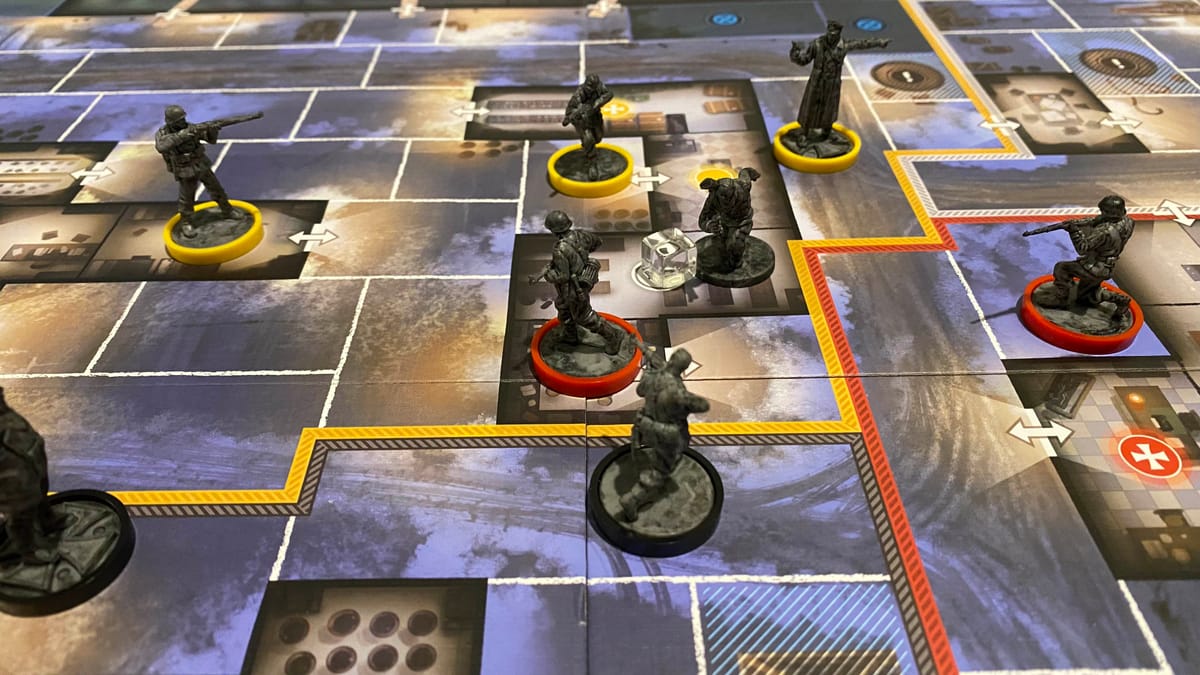
Hidden movement games are some of the most deliciously tense experiences in board gaming. This is something I've known ever since I played Scotland Yard against my father when I was a kid. The thrill of watching your opponent close a net around you only to make the slightest misjudgment, letting you slip away without ever realizing it, can't be beat. There are plenty of modern takes on this idea, such as Letters from Whitechapel or Last Friday, each with their own mechanics for both giving the non-hidden team information about the hidden player's location and letting the hidden player escape when in danger. Sniper Elite: The Board Game, designed by David Thompson & Roger Tankersley, is far and away my favorite. It not only keeps the gameplay tight and snappy without too many extra mechanics, but it seamlessly merges the hidden movement genre with miniature skirmish games to create a wonderful hybrid. The game pits one player against a team of one to four players. The single player controls a Sniper, Karl Fairburne, and uses both hidden movement and a sniping mechanic to work their way towards two random objectives on the map. The other team has three squads of Defenders, German WWII soldiers, who patrol the map and defend the objectives while they either hunt for the Sniper or run down the clock.
Components and Rules
The miniatures in this game come with a nice wash over them, which really helps me feel satisfied with not needing to (poorly) paint them. Their sculpts are fine, mostly standard German soldiers (it's worth mentioning that there is no Nazi imagery anywhere in the game, just the WWII German cross) and there's only so much you can do with them. But I will applaud the creators since each figure has a unique pose, even though only the Elite units need to stand out. I also like the pose they have for the Sniper; even if it's usually not on the board, it helps get the Sniper player into the headspace of a lone operative trying to somehow pull off a stealthy run.
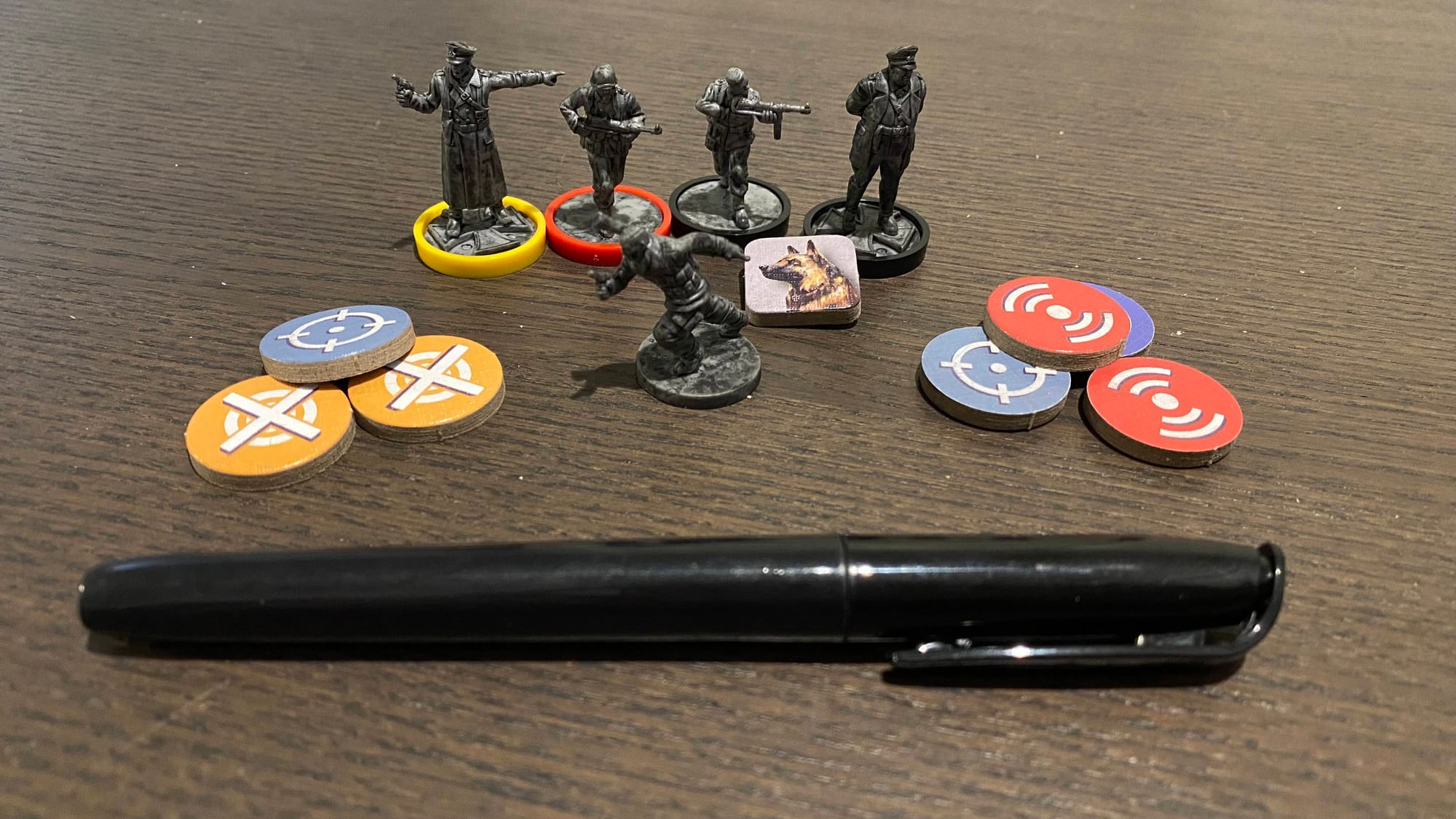
The cardboard tokens, mostly for the Sniper's shot bag but also his health and the dog tokens, are incredibly thick and satisfying. Especially when you need to blindly grab several from a bag, it helps when the tokens aren't thin and chintzy, so I love how chunky these are. The cards are also a decent quality and shouldn't need sleeving to keep them from being damaged by regular play. The dry erase boards used to track the Sniper's movement are sturdy, and the marker is one of the nicer ones I've seen included in a game, though there aren't any erasers/cloths included.
The rules are easy to read and comprehend, and everything is organized in a way that makes sense and can be quickly referenced. Something I especially liked that I don't recall seeing elsewhere is how they used the sidebars of each page. In addition to including examples and some images for some rules, they also put in FAQs right next to the relevant rules themselves. It shows a strong understanding of how many players will approach the game when learning it and what might need more precise clarification. I wish more games would do this, especially heavier ones, since Sniper Elite is rather light.
Gameplay
The actual mechanics in Sniper Elite are pretty simple, even if your strategy isn't. Everything revolves around the chosen map, made up of irregularly shaped spaces and grouped into four colored sectors. To set up the game, the Defender places their three colored squads into their corresponding spaces (the fourth sector is white and isn’t connected to any squad) and selects a specialist unit for each. These specialists each have a special action they can do twice per game, which I’ll touch on later. The Sniper then secretly draws two objective cards, which correlate to specific spots on the board. If they draw two objectives in the same sector, they keep one and replace the other to ensure the game isn’t unbalanced in their favor. Then the Sniper chooses any three loadout cards to start with, each giving them a one-use ability of some sort. Finally, the Sniper chooses one of the starting spaces in a sector without an active objective before taking the first turn.
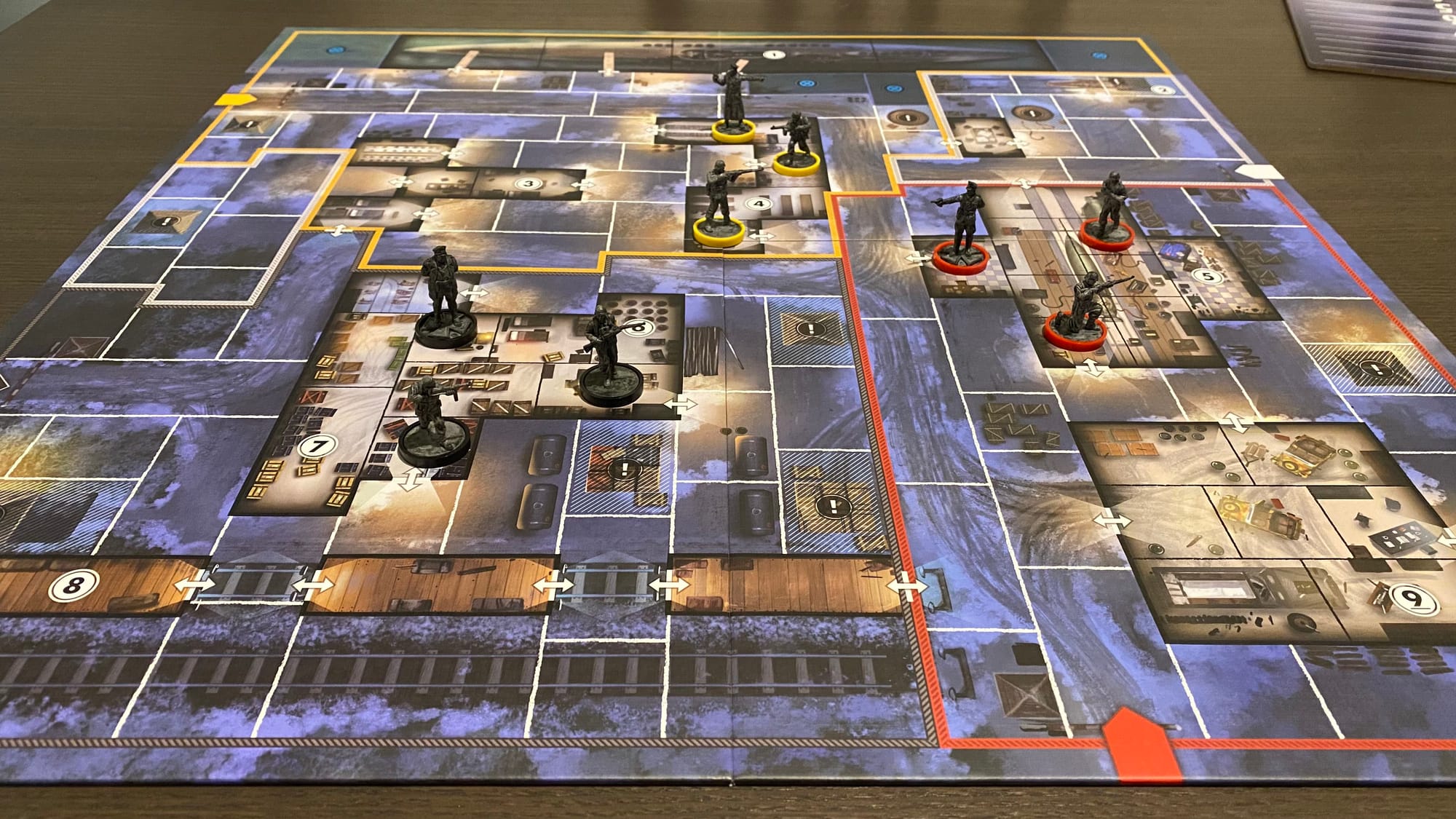
While the Defender has all their miniatures sitting nicely on the board, the Sniper is seldom present, instead recording their position and movement on a smaller dry-erase version of the map. When the Sniper moves, they have an important choice to make. Do they want to move quietly or move quickly? Moving quickly lets them travel up to three spaces, but alerts any Defenders nearby that they heard a noise (though they don’t get to know from where). Moving quietly, on the other hand, won’t alert any Defenders but can only move the Sniper a single space. This creates a nice balance between speed and stealth. Aside from moving, the Sniper only gets one action to either shoot or claim an objective, so they can't easily blast their way through a mission (at least more than once, since the Trench Gun card can clear a pretty big area). With only 10 turns to accomplish the first objective and reset the timer, the Sniper is encouraged to keep moving towards their goal rather than sneaking around and Looting everything. Shooting is kept simple with just selecting a target in Line of Sight, then drawing tokens from a bag and hoping to draw at least as many Aim tokens as there are spaces between the Sniper and their target. If the Sniper draws two noise tokens, they alert the Defender to their exact position, which is the biggest risk of attempting a shot. Successfully killing a target has a bonus of improving the Sniper's bag with Aim or Suppression tokens.
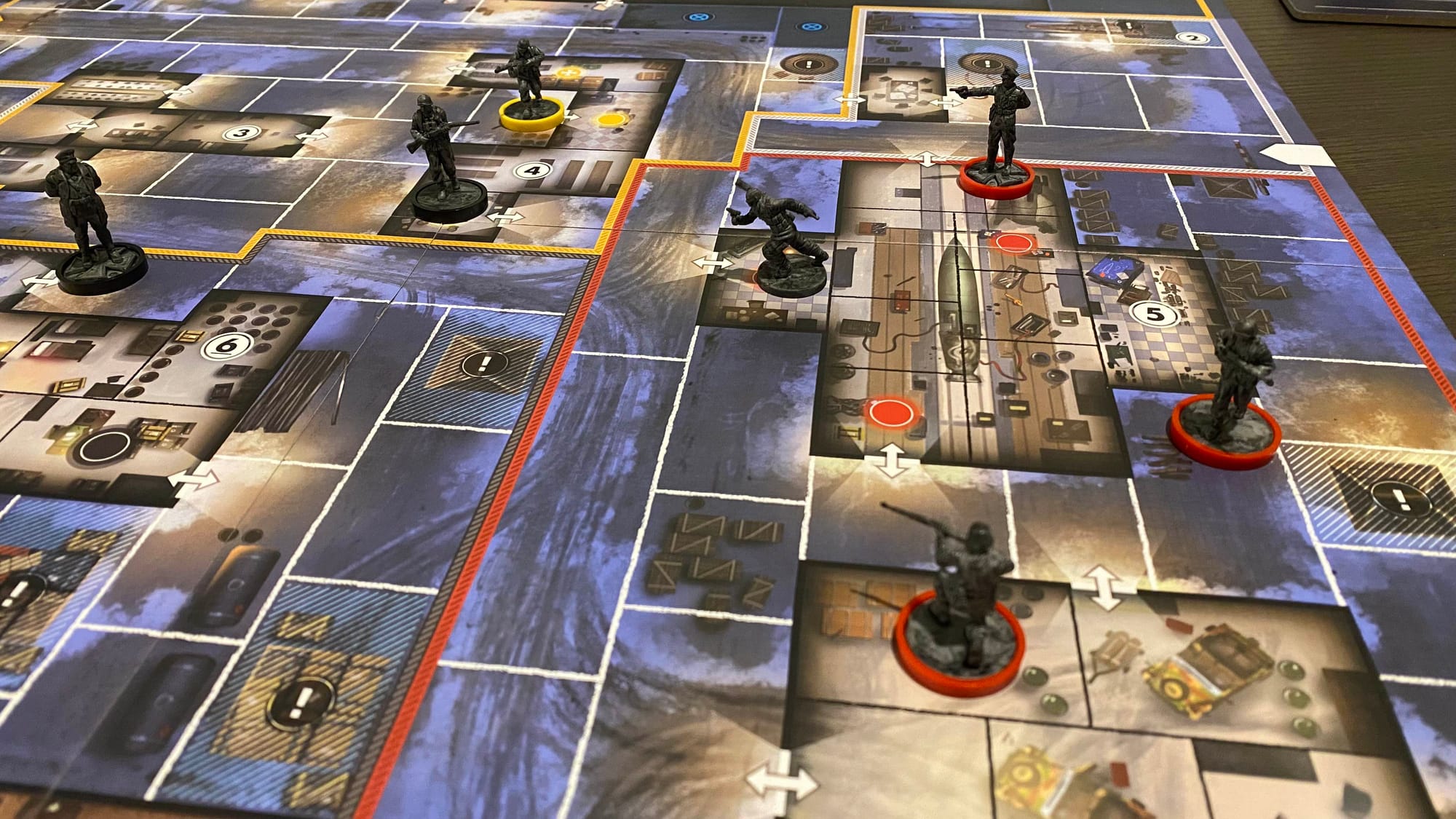
Line of Sight (LoS) is where this game gets a bit tricky. It starts simple enough: draw a line from any edge of your space to any edge of the target’s space. But unlike in most other games, you can shoot into or out of buildings in Sniper Elite… sometimes. If the Sniper is not in a building, they can shoot into any building they see as long as LoS isn’t traced through any “interior” spaces. In other words, the target has to be up against the wall or a doorway, since LoS would only be traced into that interior space and not clean through it. This rule also prevents the Sniper from tracing LoS through a building and into the exterior spaces on the other side. If the Sniper is inside a building, they have LoS to anything else inside and are allowed to trace LoS to other spaces as normal, including to targets in other buildings that are against a wall, as long as the Sniper is also against a wall in their own building. This seems like a lot, and can be a little tricky at first, but there are five different examples in the rules to help players get there. And once players understand it, they can trace LoS without any hassle.

Loadout cards are key in getting the Sniper to their objectives. Some eliminate Defenders, such as the S-Mine, which kills any Defender that steps on it, or the Trench Gun, which kills all Defenders around the Sniper at the cost of revealing themselves. Meanwhile, others are focused on discretion and misdirection. Sound Masking lets the Sniper move quickly without alerting any nearby Defenders, and a well-timed Distraction can move a Defender away from where you need to be (or where the Sniper wants the Defender to think they need to be). The effects are all intuitive, and while none is especially overpowered, they make a noticeable impact on the Sniper’s strategy.
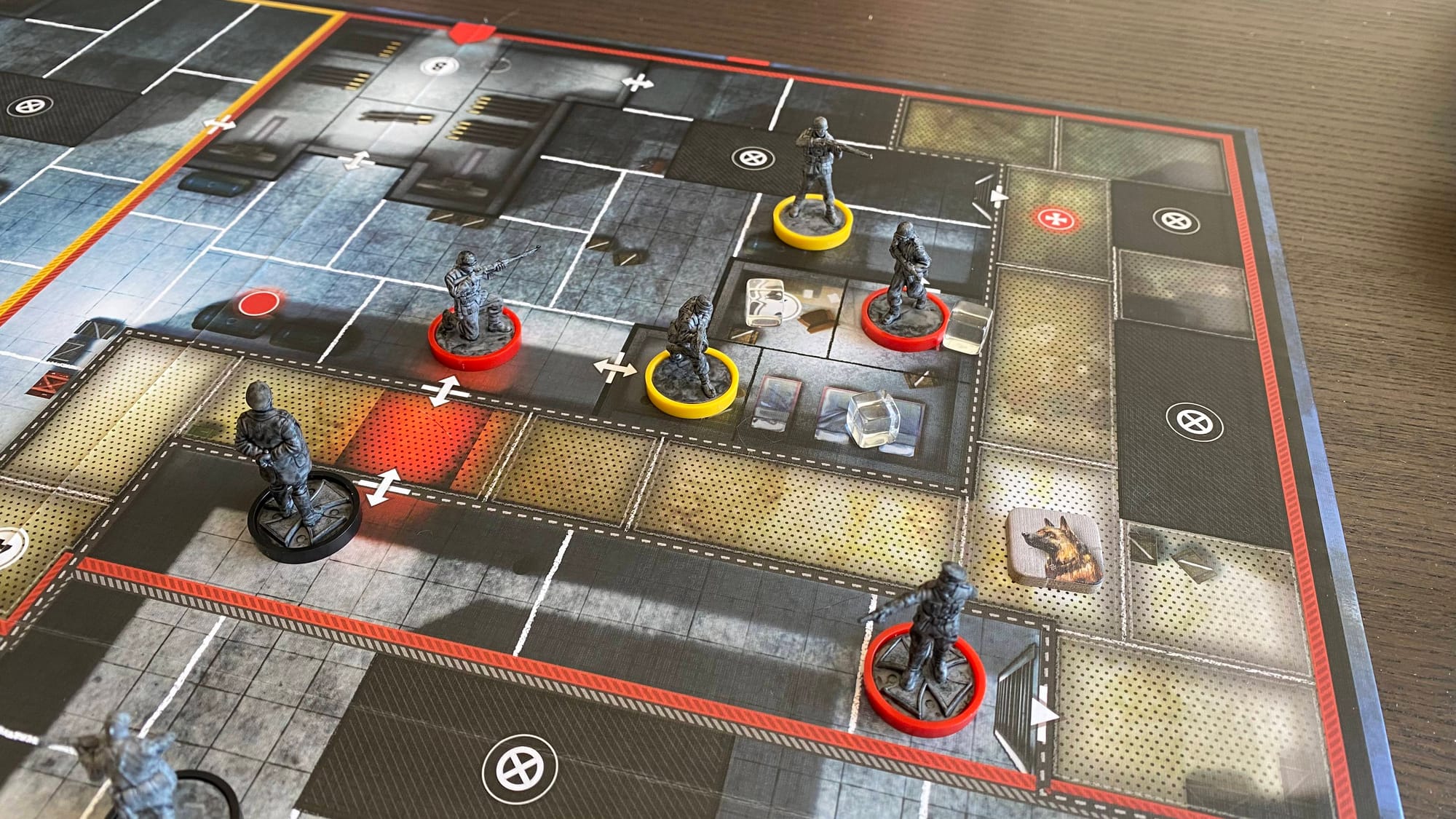
The Defenders have three squads to patrol the board with and guard the objectives, only needing to hit the Sniper twice to win the game. Usually, each squad gets two actions each round, but the Defenders can instead lose a squad's actions to ask if the Sniper is in that sector, which means the player can always get a decent idea of where the Sniper is hiding. Even if the Sniper manages to reach their first objective, it alerts the Defenders by revealing the objective—which the Sniper is now at most one Move away from—and adds more Noise to the Sniper's bag. This is a great chance for the Defenders to come back from behind and catch the elusive Sniper before they slip away again.

Defenders also get to assign one specialist unit to each squad, each with a unique special ability usable twice per game. The Radio Operator and Scout both have mechanics for getting units exactly where they need to be quickly, the specialist Sniper and Jager both have better ways to attack the enemy Sniper, the Kennelmaster can deploy dogs that alert when the Sniper is near, and the Medic can prevent his units from dying. The only specialist that’s a little odd is the Sniper, because he not only shares a name with the enemy Sniper, but he also shares the same shot bag. Twice per game, the specialist Sniper can pick a space and use the shot bag to attempt to shoot the enemy Sniper. If the shot is successful and the enemy Sniper is there, he’s immediately damaged like a regular attack. Every specialist has their use, even if the Radio Operator feels a bit more niche.
Typically in hidden movement games, one team’s goal is just to locate the hidden player, while the hidden player needs to either evade capture or quietly pick off the other team one by one. What I’ve described, though, is quite different. Finding the Sniper isn’t enough; the Defenders need to catch and damage the Sniper twice. While the Sniper’s primary goal is to evade the Defenders and reach the two objectives, they’re free to kill Defender units wherever they like. The maps don’t have node-based movement but resemble a skirmish game map instead. But it never feels like a clunky mishmash of mechanics when playing, instead, it seems like this is how stealth games should have always been.
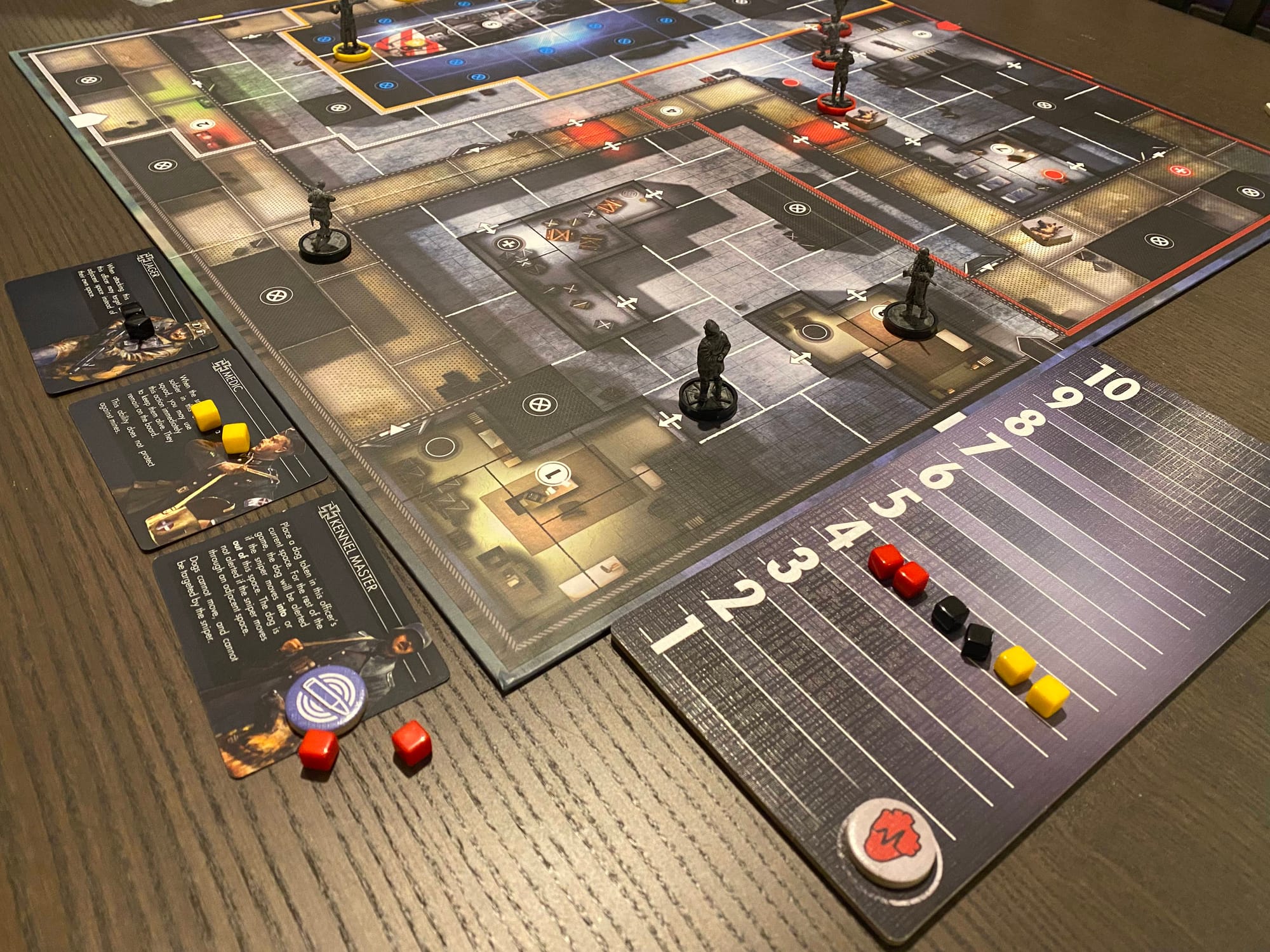
Because the objectives of each game are random and both players can slightly customize their bonus abilities, no two games will be approached in the same way. Even if the Defender player has an initial "patrol" they start their units on, things will change quickly depending on where the Sniper needs to go and how they plan on getting there. A particularly trigger-happy Sniper may be easier to locate, but will take a team effort to pin down.
If that wasn't enough, the game comes with two very different maps to play on. The “base” map, Launch Facility, has an open area cluttered with buildings that have multiple entrances, allowing the Sniper multiple possible positions to take out any given target from. The road winding across the map can make it easy for the Sniper to travel long distances, but it also benefits the Defenders, who can patrol along it and quickly close in on the Sniper once they’re discovered.
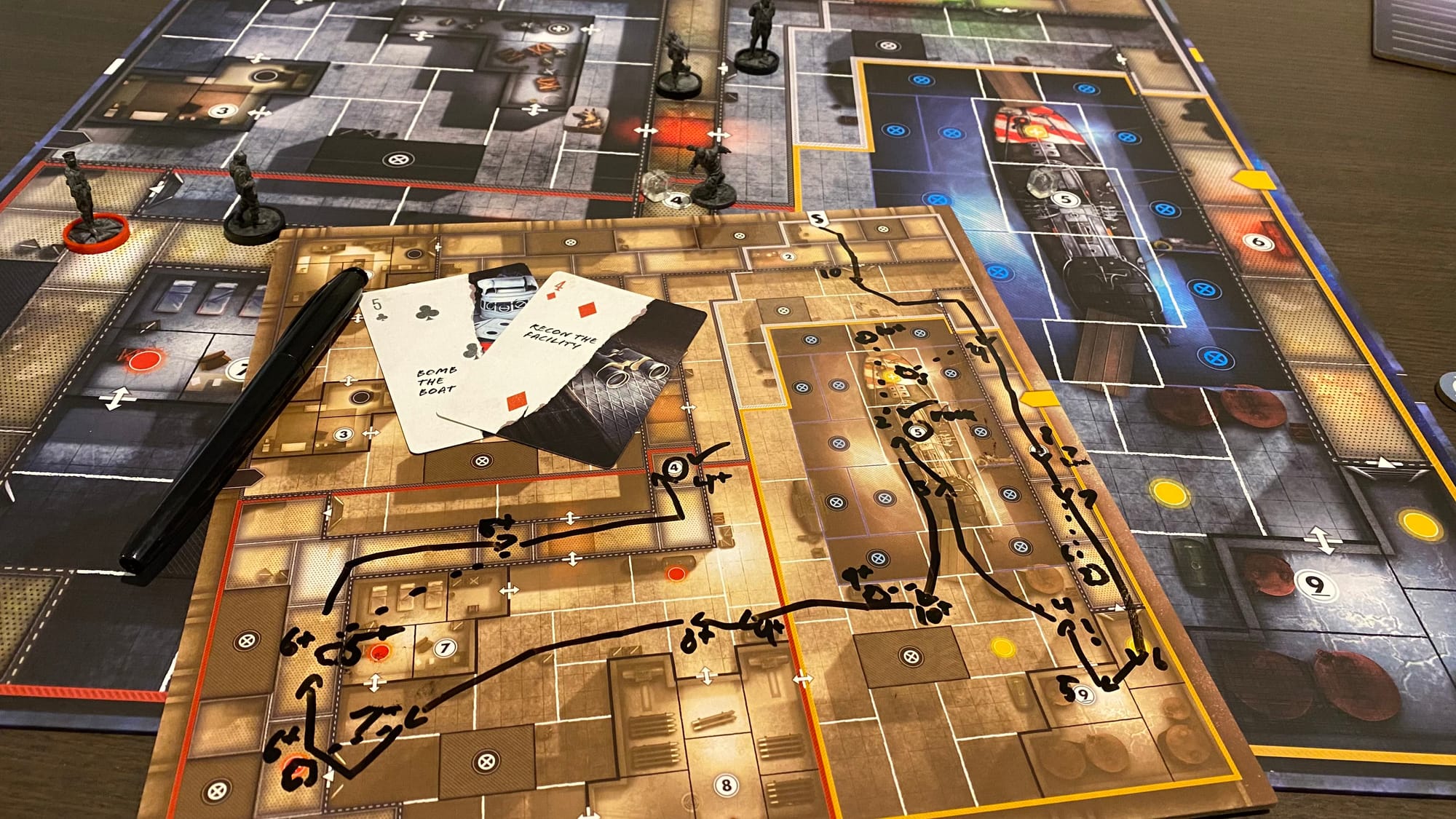
The Submarine Pens map doesn’t have quite as many enclosed spaces, instead featuring an elevated walkway that includes special rules for line of sight. You can only enter or exit this narrow path from the ladder spaces, and the path blocks movement on the lower areas except through two tunnel spaces. The Defenders’ dogs come in handy here, effectively blocking or at least alerting at key chokepoints, but the Sniper’s S-Mines can be used to deadly effect.
Both maps are very fun to play, and neither seems to favor one side more than the other. Each time I tried a new map as one team, I finished the game immediately wanting to replay it as the opposite team just to see if I could do it better than my opponent.
Solo
Dávid Turczi & Noralie Lubbers took the core gameplay and created an entirely new puzzle to solve for solo players. The Sniper plays the game almost identically, but has a pool of health instead of a single wound token. More health means it essentially becomes a resource to spend when making riskier plays against the somewhat predictable Defender AI.
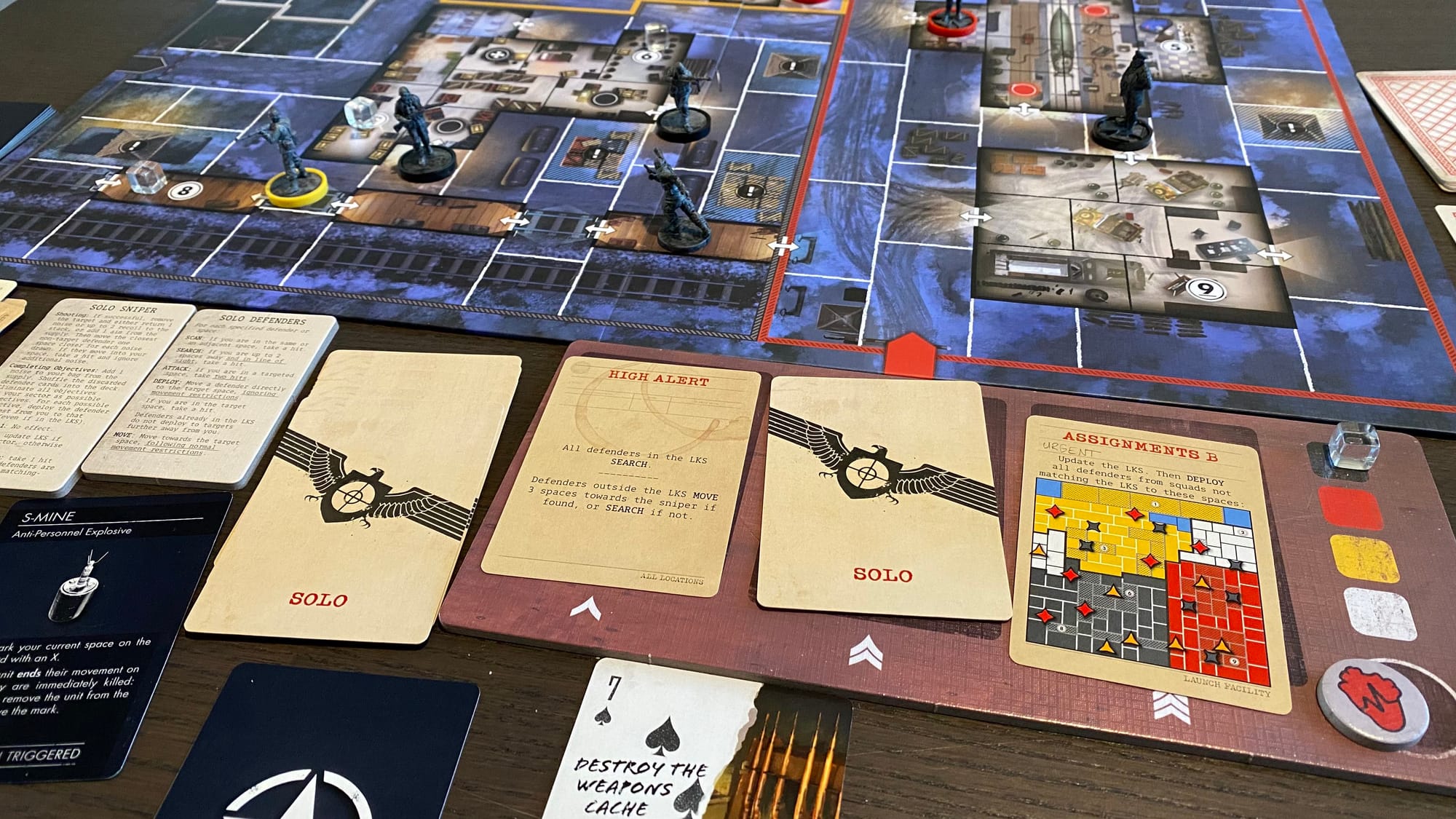
Since a board game can’t actually “deduce” where the player is hiding, they’re instead usually aware of which sector the player is currently in and will activate a random action card each turn. While random, two out of three options available to the Defender are visible to the player at any given time, allowing the Sniper to mitigate their risk and plan around most of the Defender’s actions. Some of these cards are universally applicable, but each map includes its own set of solo cards, so you can expect the Defender AI to take full advantage of a map’s individual quirks and mechanics.
I did enjoy this solo mode quite a bit. It felt like I was playing a typical stealth action video game with a predictable AI that I could manipulate and play around. Unfortunately, I never experienced the same thrill as in the multiplayer game—the solo mode feels like a puzzle more than anything. I don’t think I would recommend purchasing Sniper Elite purely for the solo mode, but anyone purchasing this game should absolutely try it out. Unlike most solo mode additions, this is one that I will be coming back to outside of reviewing.
Final Comments
I love this game. Every time I packed the game up, I was itching to get it back out and play another round, even after playing three times in one day. The hidden movement plays wonderfully as a two-player head-to-head experience, though more Defender players could be both a blessing and a curse, as lengthy discussion may slow the game down (a problem of any hidden movement game, no way around it). Defenders can also suffer from going several rounds without meaningful information if they play poorly, making it difficult for new players to enjoy the experience until they have a better understanding of what to do. Though this can be remedied by the suggested difficulty adjustments in the rules. Line of sight is likely the most contentious part of the game; I found it pretty intuitive, but I can see why others may struggle with it, since there are some odd quirks compared to standard skirmish games’ LoS, mostly with the ability to shoot into or out of buildings.
Sniper Elite: The Board Game
Excellent
Fantastic hidden movement game that provides a unique twist on the genre. Highly replayable with different maps and customized loadouts for both teams. New players may struggle as Defenders and Line of Sight isn't standard, but these are minor gripes in a phenomenal game.
Pros
- High replayability
- Maps strongly differ
- Clean mechanics, nothing clunky
- Quality components
- Creates some tense moments
- Simple and enjoyable solo mode
Cons
- Inexperienced Defender players may struggle
- Line of Sight has a few quirks to get used to
- Solo mode lacks the same intensity as base game
This review is based on a retail copy provided by the publisher.
